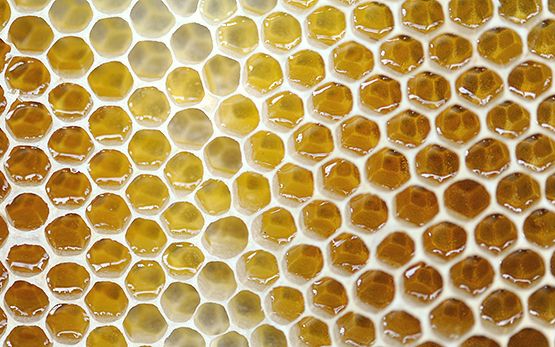Der Wassergehalt des von den Pflanzen produzierten Nektars kann variieren. Um seine Konservierung in den Waben zu gewährleisten, darf er nicht gären. Deshalb wird er von den Bienen in Honig umgewandelt, indem sie seinen Wassergehalt senken und folglich den Zuckergehalt erhöhen. Dies verhindert die Entwicklung der Mikroorganismen. In der Dunkelheit des Bienenstocks ist es schwierig, den Herstellungsprozess des Honigs zu beobachten. Aus diesem Grund ist er auch nur wenig erforscht. Um die Umwandlung von Nektar in Honig zu untersuchen, haben wir die Technik der Tomographie eingesetzt. Sie ermöglicht es, den Zuckergehalt des eingelagerten Nektars sehr präzise zu messen, ohne den Bienenstock öffnen zu müssen und das Bienenvolk zu stören.

Publications Matthias Suter
Hofer D., Suter M., Buchmann N., Lüscher A.
Severe water deficit restricts biomass production of Lolium perenne L. and Trifolium repens L. and causes foliar nitrogen but not carbohydrate limitation.
Plant and Soil, 421, (1), 2017, 367-380.
Suter M., Lüscher A.
Habitatpräferenzen von Jakobs- und Wasser-Kreuzkraut und Risikofaktoren für deren Auftreten.
DVL-Schriftenreihe „Landschaft als Lebensraum“, 23, 2017, 9-17.
Finn J.A., Brophy C., Kirwan L., Connolly, J., Suter M., Huguenin-Elie O., Lüscher A.
Plant diversity in intensively managed grasslands can improve resource use efficiency and alleviate effects of extreme climate events.
Dans: 54ª. Reunião Anual. 24 a 28 de Julho, Ed. Sociedade Brasileira de Zootecnia, Foz do Iguaçu – Brasil. 2017, 198-206.
Suter M., Zehm A., Peratoner G., Schroeder L., Nies V., Huckauf A., Bezemer M., Kollmann J., Bassler G.
Göttinger Erklärung zum Umgang mit Kreuzkräutern auf relevanten Flächen des Naturschutzes.
Dans: Internationale Tagung "Kreuzkräuter und Naturschutz". 31. Jan. bis 1. Feb., Ed. Deutscher Verband für Landschaftspflege DVL, Göttingen. 2017, 1-4.
Helgadóttir Á., Gylfadóttir T.Ó., Suter M., Kristjánsdóttir T.A., Lüscher A.
Grass-legume mixtures sustain yield advantage under cool maritime growing conditions over a period of five years.
Grassland Science in Europe, 22, 2017, 336-338.
Suter M., Hofer D., Lüscher A.
Drought resistance of functionally different forage species is related to their nitrogen acquisition and deficiency.
Grassland Science in Europe, 22, 2017, 431-433.
Finn J.A., Suter M., Haughey E., Hofer D., Lüscher A.
Short- and long-term effects on yield of grassland monocultures and mixtures exposed to simulated drought.
Grassland Science in Europe, 22, 2017, 320-322.
Suter M., Hofer D., Lüscher A.
Weed suppression enhanced by increasing functional trait dispersion and resource capture in forage ley mixtures.
Agriculture, Ecosystems & Environment, 240, 2017, 329-339.
Hofer D., Suter M., Buchmann N., Lüscher A.
Nitrogen status of functionally different forage species explains resistance to severe drought and post-drought overcompensation.
Agriculture, Ecosystems & Environment, 236, 2017, 312-322.
Stutz C. J., Huguenin-Elie O., Gago R., Suter M., Hebeisen H., Lüscher A.
Le campagnol terrestre peut-il être maîtrisé à l'aide de barrières?
Recherche Agronomique Suisse, 7, (9), 2016, 396-403.
autres langues:
Suter M., Hofer D., Lüscher A.
High functional dispersion of forage mixtures suppresses weeds in intensively managed temperate grassland.
Grassland Science in Europe, 21, 2016, 591-593.
Hofer D., Suter M., Haughey E., Finn J. A., Lüscher A.
Annual yields of intensively managed grassland mixtures only slightly affected by experimental drought events.
Grassland Science in Europe, 21, 2016, 877-879.
Hofer D., Suter M., Haughey E., Finn J. A., Hoekstra N., Buchmann N., Lüscher A.
Yield of temperate forage grassland species is either largely resistant or resilient to experimental summer drought.
Journal of Applied Ecology, 53, (4), 2016, 1023-1034.
Lüscher A., Suter M., Finn J. A.
Legumes and grasses in mixtures complement each other ideally for sustainable forage production.
Legume Perspectives, 12, (April), 2016, 8-10.
Suter M., Connolly J., Finn J. A., Loges R., Kirwan L., Sebastià M.-T., Lüscher A.
Nitrogen yield advantage from grass–legume mixtures is robust over a wide range of legume proportions and environmental conditions.
Global Change Biology, 21, (6), 2015, 2424-2438.
Hoekstra N. J., Suter M., Finn J. A., Husse S., Lüscher A.
Do belowground vertical niche differences between deep- and shallow-rooted species enhance resource uptake and drought resistance in grassland mixtures?
Plant and Soil, 394, (1), 2014, 21-34.
Hofer D., Suter M., Hoekstra N. J., Haughey E., Eickhoff B., Finn J. A., Buchmann N., Lüscher A.
Important differences in yield responses to simulated drought among four species and across three sites.
Grassland Science in Europe, 19, 2014, 166-168.
Huguenin-Elie O., Collins R. P., Hoekstra N. J., Hofer D., Husse S., Suter D., Suter M., Lüscher A.
Mischungseffekte unter unterschiedlichen Bedingungen.
Mitteilungen der Arbeitsgemeinschaft Grünland und Futterbau, 16, 2014, 136-141.
Huguenin-Elie O., Husse S., Suter M., Hoekstra N. J., Lüscher A.
Final report describing options for improving the environmental roles of grassland at the field level through the optimisation on the botanical composition of the swards.
MultiSward , D3.6. FP7-244983, 2014, 1-44 pp.
Lüscher A., Suter M., Finn J., Collins R., Gastal F.
Quantification of the effect of legume proportion in the sward on yield advantage and options to keep stable legume proportions (over climatic zones relevant for livestock production).
Animalchange Seventh Framework Programm, Theme 2: Food, Agriculture and Fisheries, and Biotechnologies. FP7 - 266018, 2014, 1-35 pp.





